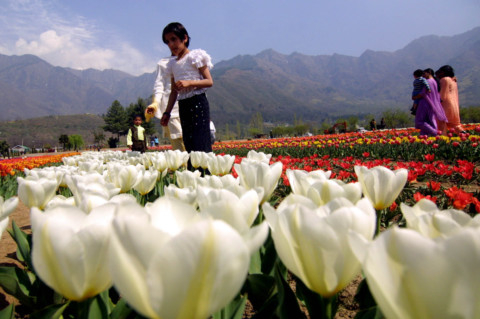
When the Department of Floriculture in the north Indian state of Jammu and Kashmir closed its Tulip Garden on April 26, it was hounded by calls and appeals from both tourists and locals alike.
Everybody wanted the garden to be opened for more days — despite the fact that tulips which have a short lifespan were beginning to die out.
The department ultimately relented and opened the garden for few extra days.
“It was an unprecedented response,” explains Talat Pervez. He’s the secretary of the floriculture department that oversees the garden.
“There was only 10 per cent bloom left for tulips in the garden, but there was no let-up in the rush of visitors to it and we had to keep garden open for a few more days.”
That April 26 closing date was pushed back to May, and it stayed open for longer than any other year.
Indeed, over the years, the magic of the Tulip Garden in Srinagar has grown to new levels.
People eagerly wait for its opening in late March, and the blooming tulips have now become synonymous with the landscape of Kashmir.
This year, more than 200,000 visited it — a huge number considering the security concerns, restrictive conditions and curfews in the state.
Since it first opened in 2007, the Tulip Garden has steadily become one of Kashmir’s major attractions, with visitors timing their trips to the region to coincide with the flowers’ short blooming season.
The garden is at the foothills of the Zabarwan Range overlooking panoramic Dal Lake. Close by are Nishat Bagh and the Chasha Shahi garden, two other attractions popular with tourists.
“We came here for this garden only,” Simran Kakkar, a tourist from New Delhi tells Weekend Review.
“This year we came here for just one day to see the Tulip Garden."
"Last year we couldn’t come and missed the chance but this year, we took time out to visit. This is amazing and something different. Acres and acres of flowers at one place is beautiful. One cannot find such a garden anywhere else in India, surrounded by beautiful mountains.”
Taking a risk
Tourists such as Kakkar visit Kashmir merely to see the tulips, and are willing to take a risk despite the ongoing security situation in Kashmir.
Attracting tourists is difficult in the current scenario but the garden has emerged as one of the rare places in Kashmir that has managed to place itself on the tourist map despite the challenges.
The gardens themselves are immaculate with vast rows of red, white, orange and yellow flowers predominating over the 40 or so different pastel shades and varieties
The garden is spread over an area of 17.5 acres and has an estimated 1.2 million tulips blooming at its peak, prompting blogger Kamiya Jani to dub it “India’s answer to Keikenhoff in The Netherlands”, the world’s biggest and best-known tulip garden.
On any day at the Kashmir attraction, people are enjoying the blooms, clicking selfies, updating their social media profiles with shots from every angle, thanks to the free Wi-Fi provided inside the garden. And that itself is helping spread the garden’s popularity and driving visitor numbers from across India, with long queues at the main gate.
The garden is constantly updated. Every year more rows of different colours and varieties are supplemented with additional attractions. Be it the creation of more green space, establishing fountains and a water channel or, simply planting new varieties of flowers, the garden is improving each season. This year, in addition to tulips, 10 varieties of Hyacinth — 40,000 bulbs in all — were planted in a separate terrace, while daffodils, narcissus and other ornamental plants have been planted too.
The garden has caught the attention of Bollywood too, and it has become a regular location spot for film units wanting to shoot a song or romantic sequence.
The garden has been receiving recognition from other platforms too. It is ranked among the top five tulip destinations in the world by the 7th World Tulip Summit Society in Ottawa. It beat tough competition from similar gardens in 17 countries including the United States, Japan, Turkey, The Netherlands, the United Kingdom and China. It 2015, it was rated as the second-best tulip destination of the world by the same society at a South Korea summit.
This year, the London-based World Book of Records included it in its record book for witnessing a bloom of 1,225,000 tulip bulbs in 70 varieties this year. Officials in Kashmir hope the accolade will further promote the garden on the international stage.
This season, footfall increased by 25 per cent over last year, providing a solid base for tourism numbers in the struggling sector in Kashmir. This year too, the tulip season threatened to close earlier following an outbreak of violence that killed 23, left scores injured and resulted in a curfew.
Interestingly, botanists believe tulips originated in Kashmir.
“In olden days, almost all the houses in Srinagar and other towns used to have thatched roofs on which soil was spread,” Farooq Dar, an elderly resident of the region, says. “Tulips used to be grown on these roofs and it used to present a beautiful scene during spring season when the wild varieties of tulips bloomed,” adding that visitors then wrote about in travelogues.
Now, the success of the Tulip Garden continues that tradition in a new way.
Haroon Mirani is a writer based in Srinagar, India.












